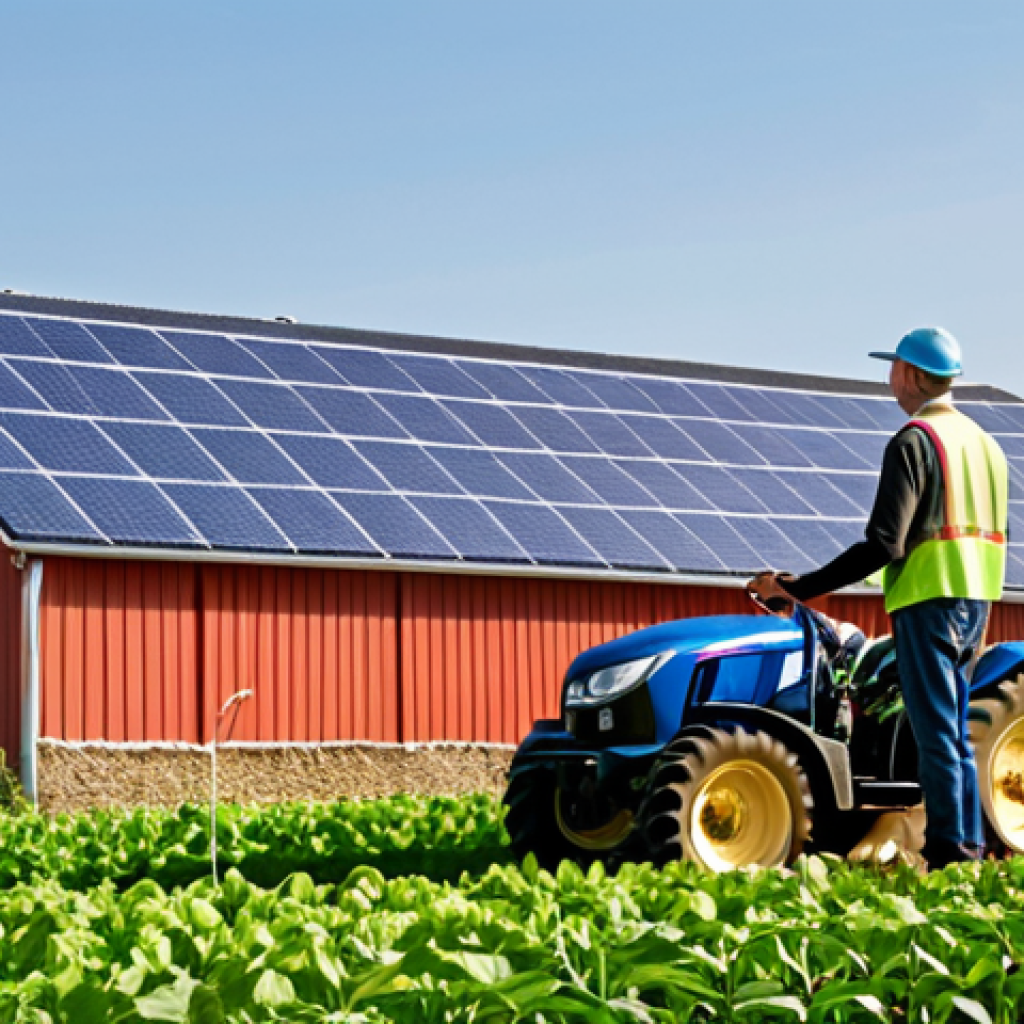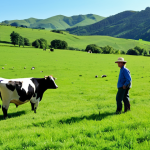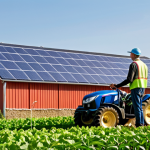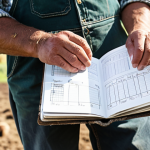Okay, here’s a blog-style introduction about government support programs for the livestock industry, keeping all your constraints in mind:Let’s face it, running a farm, especially one focused on livestock, is no walk in the park.
The costs keep rising, and let’s not even get started on the unpredictable market prices. I’ve seen firsthand how these pressures can crush even the most dedicated farmers.
Thankfully, governments often step in with support programs designed to ease the burden. Think of them as a helping hand when you need it most, giving you a bit of breathing room to invest in your operation and stay afloat.
These programs range from financial aid to technical assistance, aiming to boost efficiency and sustainability. It’s like having a secret weapon in your arsenal.
Let’s dive in and find out what’s out there. Let’s figure out the details in the following article!
Alright, here we go:
Securing Your Farm’s Future: Navigating Government Aid
1. Understanding Direct Financial Assistance Programs
Direct financial assistance programs are often the most immediately helpful. Think of them as a cash injection into your operation. I remember when I first started raising cattle; feed costs were through the roof. I was seriously considering scaling back, but then I discovered a government grant specifically designed to help with feed expenses. It was a game-changer. These programs can come in the form of direct payments, subsidies, or even low-interest loans. It’s essential to research what’s available in your region because each state or territory often has its own unique offerings. These programs often target specific needs, like drought relief, infrastructure improvements, or adopting new technologies. Applying can be a bit of a hassle, with paperwork and eligibility requirements, but trust me, the payoff is worth it. I’ve always found it helpful to connect with local agricultural extension offices. They can provide guidance and help you navigate the application process. Don’t be afraid to ask for help; that’s what they’re there for! For instance, the USDA (United States Department of Agriculture) offers a variety of farm loan programs, including operating loans and farm ownership loans. These loans can be a lifeline for farmers looking to expand or improve their operations. Keep in mind that eligibility criteria often include factors like credit history, farm size, and income.
2. Diving into Insurance and Risk Management Initiatives
Farming is inherently risky. Weather events, disease outbreaks, and market fluctuations can all wreak havoc on your bottom line. That’s where government-backed insurance and risk management initiatives come in. Crop insurance is a classic example. It protects you against losses due to natural disasters or other unforeseen events. I’ve personally benefited from livestock insurance programs that cover losses due to disease or predation. I remember one particularly harsh winter when I lost a significant number of lambs due to a sudden blizzard. Without insurance, I would have been in serious financial trouble. These programs aren’t just about covering losses after they happen; they also encourage you to adopt best management practices that reduce your risk in the first place. For example, some programs offer incentives for implementing soil conservation measures or improving animal health practices. Again, the USDA’s Risk Management Agency (RMA) is a key player here, offering a variety of insurance products tailored to different agricultural sectors. Understanding your risk profile and choosing the right insurance coverage is crucial for long-term sustainability.
Boosting Productivity: Grants for Infrastructure and Technology
1. Exploring Infrastructure Improvement Grants
Let’s be real, upgrading your farm’s infrastructure can be a seriously expensive endeavor. But here’s the thing: it’s often essential for improving efficiency and productivity. I’m talking about things like upgrading your irrigation system, building new barns, or improving your waste management facilities. Luckily, many governments offer grants specifically designed to help with these kinds of projects. These grants can significantly offset the upfront costs, making these improvements much more accessible. For example, I know a dairy farmer who used a government grant to install a new milking parlor. It not only improved the cows’ comfort but also dramatically reduced labor costs. When researching infrastructure grants, be sure to look for programs that align with your farm’s specific needs. Some grants might focus on water conservation, while others might prioritize energy efficiency.
2. Leveraging Technology Adoption Incentives
Technology is transforming agriculture at an incredible pace. From precision farming techniques to automated feeding systems, there are countless ways to use technology to improve your farm’s performance. But again, adopting these technologies can be costly. That’s why it’s worth exploring government incentives that encourage technology adoption. These incentives can take many forms, including grants, tax credits, and subsidized loans. I’ve seen programs that help farmers purchase GPS-guided tractors, install remote monitoring systems, or implement data analytics software. The key is to identify the technologies that will have the biggest impact on your farm and then seek out programs that can help you afford them. For example, some states offer tax credits for investing in renewable energy systems, like solar panels or wind turbines. These investments can not only reduce your energy costs but also make your farm more sustainable.
Training and Expertise: Subsidized Educational Opportunities
1. Benefiting from Agricultural Extension Services
One of the most valuable resources available to farmers is often overlooked: agricultural extension services. These services are typically offered by universities or government agencies and provide access to a wealth of knowledge and expertise. I’ve personally attended workshops on everything from soil health to livestock nutrition, and I’ve always come away with valuable insights. Agricultural extension agents can provide personalized advice, conduct on-farm assessments, and connect you with other experts in your field. They can also help you stay up-to-date on the latest research and best management practices. Best of all, these services are often heavily subsidized or even free.
2. Accessing Subsidized Training Programs
In addition to agricultural extension services, there are often subsidized training programs available to farmers. These programs can cover a wide range of topics, from farm management and financial planning to specific agricultural skills like welding or artificial insemination. I know a lot of farmers who have taken advantage of these programs to expand their skillset and improve their farm’s operations. For instance, I know someone who took a course on organic farming practices and successfully transitioned their farm to organic production. These training programs can be a great way to invest in yourself and your farm’s future.
- Grants can be used for:
- Building new storage facilities
- Installing new irrigation systems
- Upgrading existing barns
- Financial Support:
- Grants
- Low-interest loans
- Tax credits
Marketing Your Products: Support for Local Sales Initiatives
1. Participating in Farmers Markets and Local Food Programs
Direct marketing is a great way to connect with consumers and capture a larger share of the profits. I’ve always enjoyed selling my produce at local farmers markets; it’s a great way to get feedback from customers and build relationships. Many governments offer support for farmers markets and other local food programs. This support can include grants for marketing and promotion, technical assistance for setting up a stall, and even subsidized transportation to and from the market. I’ve also seen programs that help farmers sell their products to schools, hospitals, and other institutions. These programs can provide a stable source of income and help you reach a wider audience.
- Farmers markets can help:
- Gain customer feedback
- Build relationships with customers
2. Embracing Online Sales and E-commerce Support
In today’s digital age, selling your products online is becoming increasingly important. But setting up an e-commerce website and managing online sales can be daunting. Luckily, some governments offer support for farmers who want to embrace online sales. This support can include grants for website development, training on e-commerce best practices, and even access to online marketplaces. I know a farmer who used a government grant to create an online store for their farm’s products. They were able to reach customers all over the state and significantly increase their sales.
Sustainable Farming: Incentives for Eco-Friendly Practices
1. Implementing Conservation Programs
Sustainable farming practices are not only good for the environment but also for your farm’s long-term viability. Many governments offer incentives for implementing conservation programs that protect soil, water, and biodiversity. These programs can include cost-sharing for implementing cover crops, installing buffer strips, or restoring wetlands. I’ve personally benefited from programs that help me implement no-till farming practices. These practices have improved my soil health, reduced erosion, and saved me money on fuel and fertilizer.
2. Exploring Organic Farming Certification Support
Organic farming is a growing market, and many consumers are willing to pay a premium for organically produced goods. But transitioning to organic farming can be a challenging and expensive process. That’s why some governments offer support for farmers who want to become certified organic. This support can include cost-sharing for certification fees, technical assistance for organic farming practices, and marketing support for organic products. I know a farmer who used a government grant to help them transition their farm to organic production. They were able to increase their sales and attract new customers who were looking for organic products.
Navigating Bureaucracy: Resources for Applications and Compliance
1. Seeking Guidance from Government Agencies
Navigating the world of government programs can be confusing and overwhelming. That’s why it’s important to seek guidance from government agencies and other organizations that can help you understand the rules and regulations. Agricultural extension offices, farm bureaus, and industry associations can all provide valuable assistance. Don’t be afraid to ask for help!
- Farm bureaus can provide assistance for:
- Understanding the rules and regulations
2. Developing a Comprehensive Farm Plan
One of the best ways to ensure that you’re taking advantage of all the available government programs is to develop a comprehensive farm plan. This plan should outline your farm’s goals, strategies, and financial projections. It should also identify any potential challenges and opportunities. A well-developed farm plan can help you make informed decisions, track your progress, and demonstrate your commitment to sustainable farming practices. It can also be a valuable tool when applying for government programs.Here’s a table summarizing different types of government support programs:
| Program Type | Description | Examples | Benefits |
|---|---|---|---|
| Financial Assistance | Direct payments, subsidies, low-interest loans | Drought relief, infrastructure grants, farm loans | Provides immediate financial relief and supports farm improvements. |
| Insurance & Risk Management | Insurance against weather events, disease, and market fluctuations | Crop insurance, livestock insurance | Protects against losses and encourages best management practices. |
| Education & Training | Workshops, courses, and extension services | Soil health workshops, farm management courses | Enhances skills and knowledge, leading to better farm management. |
| Marketing Support | Assistance for local sales initiatives and online marketing | Farmers market support, e-commerce grants | Helps farmers reach more customers and increase sales. |
| Sustainability Incentives | Incentives for implementing eco-friendly practices | Conservation programs, organic certification support | Promotes environmentally friendly practices and long-term viability. |
In Conclusion
Securing your farm’s future requires a multi-faceted approach. By understanding and leveraging government aid programs, embracing new technologies, and prioritizing sustainable practices, you can build a resilient and profitable agricultural operation. Remember, it’s not just about surviving; it’s about thriving in a rapidly changing world.
Don’t be afraid to reach out to local agricultural extension offices or other resources for guidance and support. There are people out there who want to see you succeed. With the right combination of hard work, innovation, and strategic planning, you can create a legacy that will last for generations. And never underestimate the power of shared knowledge and community.
Useful Information to Know
1. Regularly check USDA’s website for updated programs and eligibility requirements. Make it a monthly task!
2. Attend local agricultural workshops and seminars. Networking can unlock opportunities you never knew existed.
3. Explore cost-sharing options for implementing sustainable practices. It’s a win-win for your farm and the environment.
4. Keep detailed records of your farm’s operations. This data is crucial for applying for grants and managing your finances.
5. Consider joining a local farm bureau or agricultural association. They can provide advocacy and resources.
Key Takeaways
Government aid can provide critical financial support and resources for farmers. Prioritize understanding direct financial assistance programs and insurance options to mitigate risks.
Invest in infrastructure and technology to boost productivity and efficiency. Explore grants and incentives that can help offset the costs of upgrades.
Embrace sustainable farming practices to protect the environment and ensure long-term viability. Implement conservation programs and consider organic certification.
Seek guidance from government agencies and develop a comprehensive farm plan. Navigate bureaucracy effectively to maximize available benefits.
Take advantage of subsidized educational opportunities and training programs to enhance your skills and knowledge. Continuous learning is key to staying ahead in the ever-evolving agricultural landscape.
Frequently Asked Questions (FAQ) 📖
Q: What specific types of financial assistance are typically offered in government support programs for livestock farmers?
A: Typically, you’ll find direct payments to offset production costs, loan guarantees to help you secure better interest rates when borrowing money for improvements or expansion, and even disaster relief funds if, say, a crazy storm wipes out part of your herd.
Some programs also offer subsidies on things like feed or fuel, which can really make a difference in your monthly expenses. It’s always best to check the details for each program to see exactly what’s covered.
Q: How can I, as a livestock farmer, determine which government support programs I’m eligible for?
A: The best starting point is usually your state’s Department of Agriculture website or your local extension office. They’ll have detailed information on federal and state programs, eligibility requirements, and application processes.
Don’t be afraid to call them up – they’re there to help! Also, consider connecting with other farmers in your area. Word-of-mouth is surprisingly effective in learning about lesser-known programs or getting tips on navigating the application process.
Plus, it’s just good to have that support network!
Q: Besides financial aid, what other kinds of support do these government programs offer to livestock producers?
A: It’s not just about the money! Many programs offer technical assistance and training. Think workshops on improving animal health, managing pastures more efficiently, or implementing sustainable farming practices.
Some even provide grants for research and development, allowing you to try out innovative technologies or production methods. These resources can be invaluable in boosting your farm’s productivity and ensuring its long-term sustainability.
📚 References
Wikipedia Encyclopedia
2. Securing Your Farm’s Future: Navigating Government Aid
1. Understanding Direct Financial Assistance Programs
Direct financial assistance programs are often the most immediately helpful. Think of them as a cash injection into your operation. I remember when I first started raising cattle; feed costs were through the roof. I was seriously considering scaling back, but then I discovered a government grant specifically designed to help with feed expenses. It was a game-changer. These programs can come in the form of direct payments, subsidies, or even low-interest loans. It’s essential to research what’s available in your region because each state or territory often has its own unique offerings. These programs often target specific needs, like drought relief, infrastructure improvements, or adopting new technologies. Applying can be a bit of a hassle, with paperwork and eligibility requirements, but trust me, the payoff is worth it. I’ve always found it helpful to connect with local agricultural extension offices. They can provide guidance and help you navigate the application process. Don’t be afraid to ask for help; that’s what they’re there for! For instance, the USDA (United States Department of Agriculture) offers a variety of farm loan programs, including operating loans and farm ownership loans. These loans can be a lifeline for farmers looking to expand or improve their operations. Keep in mind that eligibility criteria often include factors like credit history, farm size, and income.
2. Diving into Insurance and Risk Management Initiatives
Farming is inherently risky. Weather events, disease outbreaks, and market fluctuations can all wreak havoc on your bottom line. That’s where government-backed insurance and risk management initiatives come in. Crop insurance is a classic example. It protects you against losses due to natural disasters or other unforeseen events. I’ve personally benefited from livestock insurance programs that cover losses due to disease or predation. I remember one particularly harsh winter when I lost a significant number of lambs due to a sudden blizzard. Without insurance, I would have been in serious financial trouble. These programs aren’t just about covering losses after they happen; they also encourage you to adopt best management practices that reduce your risk in the first place. For example, some programs offer incentives for implementing soil conservation measures or improving animal health practices. Again, the USDA’s Risk Management Agency (RMA) is a key player here, offering a variety of insurance products tailored to different agricultural sectors. Understanding your risk profile and choosing the right insurance coverage is crucial for long-term sustainability.
Boosting Productivity: Grants for Infrastructure and Technology
1. Exploring Infrastructure Improvement Grants
Let’s be real, upgrading your farm’s infrastructure can be a seriously expensive endeavor. But here’s the thing: it’s often essential for improving efficiency and productivity. I’m talking about things like upgrading your irrigation system, building new barns, or improving your waste management facilities. Luckily, many governments offer grants specifically designed to help with these kinds of projects. These grants can significantly offset the upfront costs, making these improvements much more accessible. For example, I know a dairy farmer who used a government grant to install a new milking parlor. It not only improved the cows’ comfort but also dramatically reduced labor costs. When researching infrastructure grants, be sure to look for programs that align with your farm’s specific needs. Some grants might focus on water conservation, while others might prioritize energy efficiency.
2. Leveraging Technology Adoption Incentives
Technology is transforming agriculture at an incredible pace. From precision farming techniques to automated feeding systems, there are countless ways to use technology to improve your farm’s performance. But again, adopting these technologies can be costly. That’s why it’s worth exploring government incentives that encourage technology adoption. These incentives can take many forms, including grants, tax credits, and subsidized loans. I’ve seen programs that help farmers purchase GPS-guided tractors, install remote monitoring systems, or implement data analytics software. The key is to identify the technologies that will have the biggest impact on your farm and then seek out programs that can help you afford them. For example, some states offer tax credits for investing in renewable energy systems, like solar panels or wind turbines. These investments can not only reduce your energy costs but also make your farm more sustainable.
Training and Expertise: Subsidized Educational Opportunities
1. Benefiting from Agricultural Extension Services
One of the most valuable resources available to farmers is often overlooked: agricultural extension services. These services are typically offered by universities or government agencies and provide access to a wealth of knowledge and expertise. I’ve personally attended workshops on everything from soil health to livestock nutrition, and I’ve always come away with valuable insights. Agricultural extension agents can provide personalized advice, conduct on-farm assessments, and connect you with other experts in your field. They can also help you stay up-to-date on the latest research and best management practices. Best of all, these services are often heavily subsidized or even free.
2. Accessing Subsidized Training Programs






